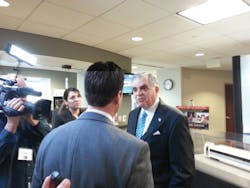USHSR: Sec. LaHood on Pushing HSR Forward
At the USHSR High-Speed Rail Conference in Washington, D.C., U.S. Department of Transportation Secretary Ray LaHood spoke to attendees on what has been accomplished and what needs to be done when it comes to high-speed rail and passenger rail in the United States.
He said within 30 days of the president being sworn into office, there was $8 billion allocated to passenger rail. During his first two years in office, when traveling to other countries to look at high-speed rail, a common thread was the idea that unless the national government makes the investment, it will not happen.
"Over the last four years our program has invested $12 billion," he stated. And that was for 154 rail projects in 34 states.
He also pointed out, "The idea that we were going to develop a plan where every train was going to go 200 mph; that was never our plan." Looking at Northeast Corridor, he said it's impossible to get to the speeds we can attain in places like California.
He said there is not enough money in Washington to implement the kind of plan they want to implement and they have encouraged manufacturers from Europe and Asia to come here. "And they're here and they're making investments." He added, "The investments of private dollars are critical."
His final point to attendees was that this is the next generation of transportation for the next generation.
Following his presentation, Sec. LaHood had an interview with CNN's Drew Griffin and responded to questions on results, speed of delivery and value of dollars spent..
In Illinois trains are going from 79 mph to 110 mph and in California they'll soon be breaking ground for high-speed rail. Amtrak has an all-time, on-time record, so the money that's been invested is going toward both upgrading existing corridors and investing in new lines.
When asked about the speed of these projects moving forward — or not moving forward — LaHood stressed it took 50 years to build the state-of-the-art Interstate system.
